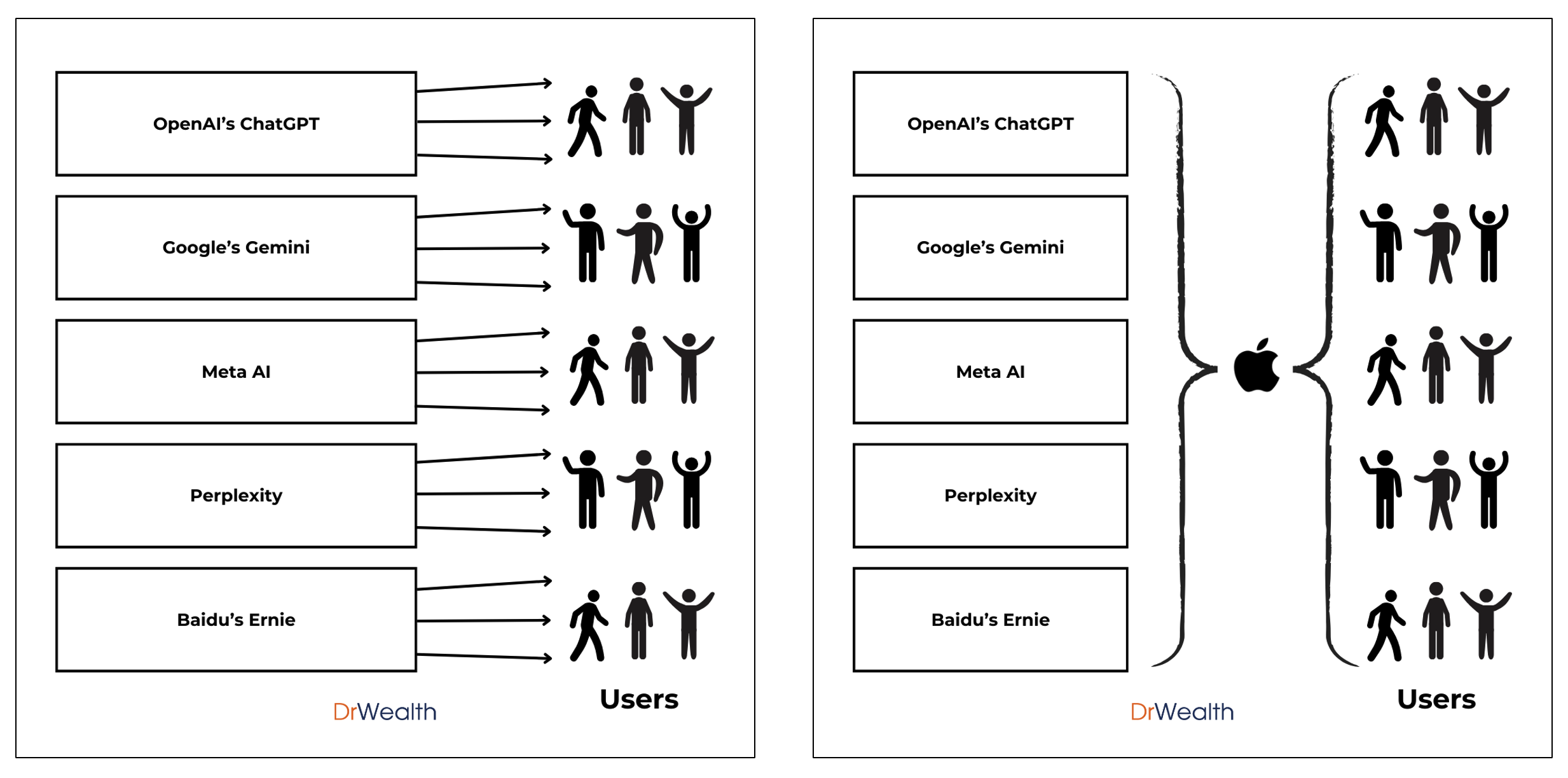Apple stock hit a new record high following its announcement to integrate more AI functions across its products. Is merely a mention of AI intention sufficient to boost the perceived value of the company, or is there possibly a real fundamental shift in the business landscape of AI?
It appears to be the latter, as Apple released more updates about its plan to integrate additional AI models. Apple is now even willing to put aside its differences with Meta and offer Meta’s Llama 3 AI model. Other AI models under consideration include Google’s Gemini, Anthropic, and Perplexity.
ChatGPT has already gained a leg up by being the first to gain widespread popularity and is now the first AI model Apple has announced it will work with. Apple is a coveted partner for distributing AI models because it has 2.2 billion active devices. If an AI company starts to acquire customers from scratch at $29 per user (the average user acquisition cost for softwares estimated by SimplicityDX), it would cost around $64 billion to equal Apple’s reach. Given the intense competition, the cost is likely to be higher. Even the successful ChatGPT has only 180 million users, so tapping into Apple’s vast distribution network will significantly lower customer acquisition costs.
Other companies also have great distribution capabilities. Meta, for instance, has 3 billion WhatsApp users, and its AI is conveniently available as a chat. Microsoft is another example, with its 1.2 billion Office users. However, the key difference is that Apple operates at the hardware level, while Meta and Microsoft operate at the software layer. This means that to use Meta AI or CoPilot, users still need to be on WhatsApp or Office at that point in time. In contrast, Apple Intelligence can assist in operating any apps users want.
Besides the sheer number of devices, Apple has a knack for making technology easy to use. Until now, most AI comparisons have focused on who has larger training sets, who is faster, and who has higher test scores. These comparisons repeat the same mistakes seen in the past with MP3 players, which touted technical specifications like having 1GB of storage without explaining what that meant to users. Apple, on the other hand, communicated simply and effectively by saying, “1,000 songs in your pocket.” This simplicity in communication, not just in design, is crucial. Whether AI is widely and frequently used by the average person will heavily depend on Apple.

What Apple is doing here aligns with Stratechery’s Aggregation Theory. Apple focuses on becoming the gatekeeper, leveraging its privileged position even though it is late to the AI game. By acting as the intermediary between AI models and users, Apple flexes its muscles to control access to its vast user base.
Before Apple decided to onboard external AI models, the AI rush had many companies developing their own AI models, each touting unique advantages. Users had to visit different platforms to use AI, with each platform vying for attention. Now, Apple has the power to decide which AI models gain access to its customers, consolidating its role as the gatekeeper in the AI landscape.

We might also find that this aggregation has been practiced by big cloud players. Amazon Web Services, Microsoft Azure, Google Cloud, and Alibaba Cloud have offered external models on their platforms as well. However, it’s important to understand that their customers are primarily developers, not the average person. Apple, on the other hand, focuses on empowering mass-market users.
The only remaining question is, what is the strategy for the other 3.9 billion Android users in the world? Although Google has its Pixel hardware, it doesn’t have a dominating market share. Therefore, Google won’t be able to control the hardware level effectively. It is dependent on what device makers choose, which can result in incompatible or under-optimized hardware for Google’s AI functionalities. Additionally, since Android is open source, manufacturers can modify the OS, potentially leading to further incompatibilities. Some manufacturers, like Huawei, have even started developing their own operating systems. In China, where Google Play Store and Google Search are not used, it’s unlikely that Google’s Gemini will gain approval. Conversely, Apple will integrate Baidu’s AI seamlessly for Chinese users.
Thus, Google will face a much harder time integrating AI into Android-powered devices due to these fragmentation issues.
We might be witnessing a powerful strategic move from Apple: the decision to become an AI aggregator rather than develop its own AI model. By focusing on integrating various AI models into its ecosystem, Apple can leverage its hardware control and user-friendly approach to deliver a superior experience. Time will tell if this strategy will enable Apple to regain its glory and become the most valuable company in the world once more.

